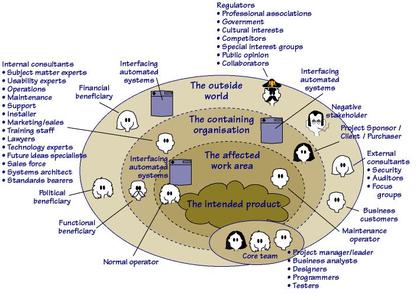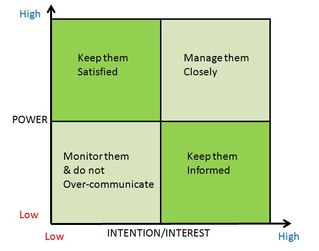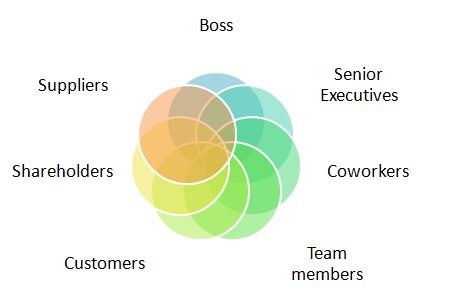Stakeholder Management
Stakeholder Management is a newly included topic for the 5th Edition PMP Syllabus, and it is for good reason. In our highly matrixed organizations, stakeholder management is becoming an increasingly important success factor in any company or organization. This is especially so when the world is becoming "flatter" -- there is a higher likelihood that you, as the project manager would be working with various nationalities and with different tiers of the hierarchy. By being able to engage with the right people in the right way when working on your project, you can then make the right difference -- to your project's success, and ultimately, to your career as a project manager.
Benefits of Stakeholder Management

Stakeholder Management is a very useful technique with many benefits. With a stakeholder-based approach, you can use the opinions of the most powerful stakeholders to shape your projects at an early stage. These stakeholders would not only support you from the onset, but their advice would help to improve the quality of the project. With the support from the stakeholders, you would have a higher possibility to gain approval for additional resources required for the project. With frequent communication, you can ensure that the stakeholders are always “in the know” and understand the key benefits of your project, and hence support you throughout the project lifespan. Moreover, you can anticipate reactions to your project and hence be able to build into your plan the right actions that will win people’s support.
Conducting a Stakeholder Analysis
 Stakeholder Map
Stakeholder Map
The first step towards Stakeholder Management is to conduct a Stakeholder Analysis. In this exercise, you will need to have relevant information that is up-to-date so that you are able to plan the communication with your stakeholders. Identify all the relevant stakeholders related to your project and compile them into a stakeholder list. In addition, it pays to mark out their positions into a Stakeholder Map, for easy visualization and identification of the role each stakeholder plays. The diagram shows an example of a stakeholder analysis context diagram, where stakeholders are broadly divided into both Internal and External stakeholders. This division will allow you to understand the internal and external stakeholders and how they inter-related to one another. While this diagram is a simple one, in reality there could be more inter-connectivity between the various stakeholders.
Brainstorming the Stakeholders
In the stakeholder analysis, you will have to brainstorm who your stakeholders are. You will have to go through everyone who is affected by your work, who have influenced over it, and have a vested interest to make it successful (or unsuccessful). Beside your boss (or your sponsor), there are many others who would either directly or indirectly impact or be impacted by your project, and therefore they invariably become related stakeholders. Some of the people who might be stakeholders are:
The list is not exhaustive, as there could be other stakeholders such as alliance partners, lenders, analysts, potential recruits, government organizations, trade associations, the press, interest groups, the public, the community and many others. During the brainstorm, leave no stones un-turned so that you are able to map out an extensive list of stakeholders. Sometimes, the most innocuous stakeholder might make a very large impact to your project, especially during the last stages of the project life-cycle.
How to Prioritize Your Stakeholders
With a long list of possible stakeholders, you must now set out to categorize them. Some stakeholders have the power to block your project or accelerate your project (in terms of power and ability) and some stakeholders would want your project to succeed while others think otherwise (in terms of intentions and interests).
Power and Intention/Interest Quadrant
 Power and Intention/Interest Quadrant
Power and Intention/Interest Quadrant
Hence a good follow up is to prepare a Power and Intention/Interest chart as shown below. I know that some Project Managers will skip the Stakeholder Analysis Context Diagram and move straight to this chart, but it is important to discern between the two. The Context Diagram shows the relationships between the stakeholders, while the Power and Intention/Interest Quadrant shows the influence and inclination of the stakeholder TOWARDS your project.
As an illustration, your boss or your sponsor is likely to wield high power and influence over your project, as well as good intentions and interest. Based on the Power and Intention/Interest Quadrant, the following would be applicable:
As an illustration, your boss or your sponsor is likely to wield high power and influence over your project, as well as good intentions and interest. Based on the Power and Intention/Interest Quadrant, the following would be applicable:
Stakeholder Communications Plan
The second step is to develop a communications plan to engage the stakeholders. This is so that you are able to convey the right messages (with the right nuances) to the stakeholder so as to update, hence win them around to support your project. You can use the following Stakeholder Communications worksheet to assist you with your stakeholder communication planning. The worksheet will include the following details:
a. Stakeholder name
b. Current status (advocate, supporter, neutral, critic, blocker)
c. Relationship and role
d. Method of communication
e. Desired support (high, medium, low)
f. Desired project role
g. Desired actions
h. Messages needed
i. Communications/Actions
(you can download the worksheet below)
a. Stakeholder name
b. Current status (advocate, supporter, neutral, critic, blocker)
c. Relationship and role
d. Method of communication
e. Desired support (high, medium, low)
f. Desired project role
g. Desired actions
h. Messages needed
i. Communications/Actions
(you can download the worksheet below)
| Stakeholder Communications Plan (Template) | |
| File Size: | 13 kb |
| File Type: | docx |
Conclusion
In conclusion, stakeholder management (or Identify Stakeholders) is the second and final process within the Initiating Process group, and is a fundamental step of the PMBOK processes - which can make a very impact in your project delivery. If you are keen to find out more about the stakeholder communications plan, I will be happy to share more during my next article. (Duke Phua)




